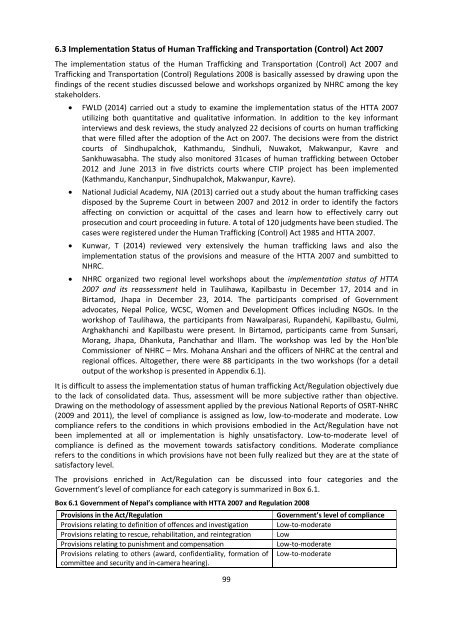TRAFFICKING IN PERSONS
1Spfyta
1Spfyta
You also want an ePaper? Increase the reach of your titles
YUMPU automatically turns print PDFs into web optimized ePapers that Google loves.
Meanwhile, her aunt noticed changes in the survivor's behavior and finally came to know that Mr.<br />
Bishnu was forcing her into prostitution. She then went to his rented room and rescued her. Then,<br />
they reached to Janasewa police station in New Road, Kathmandu to report the case.<br />
The Sub-Inspector of Police - Mr. Prem Regmi informed this case to PPR Nepal. Lawyers from PPR<br />
Nepal reached to the police station for legal advice. On 2 July 2014, the survivor’s relative filed FIR<br />
on behalf of the survivor under human trafficking against Mr. Thapa that the perpetrator forced the<br />
survivor into prostitution continuously for two months.<br />
The survivor’s health check-up and age verification was done in TU Teaching Hospital. After the<br />
health examination, she was found pregnant. As she was under aged and had unwanted pregnancy,<br />
she and her relative agreed to abort the fetus. Then, she was provided a safe shelter in Peace<br />
Rehabilitation Centre (PRC) Lalitapur.<br />
After the police investigation the case was sent to Kathmandu district government attorney's office<br />
for prosecution. On 26 August 2014, the government attorney filed the case under the HTTA 2007 in<br />
the Kathmandu District Court. On 27 August 2014, the Kathmandu District Court ordered the<br />
perpetrator to be taken in judicial custody.<br />
During the entire process lawyers from PPR Nepal provided legal counseling while PRC provided<br />
rehab service to the survivor.<br />
Source: PPR Nepal, 2015.<br />
The level of compliance regarding the reporting is low despite the NHRC recommendation to<br />
establish a unified and national level reporting system. A few cases of human trafficking are<br />
registered in Nepal Police than that of believed to be as discussed in Chapter 2. There are several<br />
reasons for under reporting of TIP cases. One, the perpetrators are often close relatives of the<br />
victims; two, many cases of TIP are a result of fraudulent promises for foreign employment, but such<br />
cases are registered under the FEA 2007, rather than under the HTTCA 2007. Three, many instances<br />
of trafficking involving men as victims are not reported as human trafficking and are instead<br />
reported under the FEA 2007.<br />
Low reporting is also evident from the Shakti Samuha (Op. cit., 2014) participants of conference. Of<br />
the total 191 trafficked survivors, only 17 percent made FIR about the trafficking while the rest did<br />
not make any complaints. Several reasons evolved as not being made FIR. Key reasons include: not<br />
having citizenship certificate (17%), no awareness (15.5%), not identifying the traffickers (10%),<br />
already death of the traffickers (8%), absconded of traffickers (4.5%), feeling of threats (4%), no<br />
support from the family (3%), because traffickers is relative (3%), because trafficker is already in Jail<br />
(1%) and no money (1%) and no meaning of complaints (1%). Among the 32 trafficked survivors who<br />
reported that they have sought legal justice, 36 cases were in the courts (27 were in district courts, 4<br />
in Appellate Courts and one in Supreme Court). Among the 36 cases, 21 cases have already been<br />
disposed. Of the 21 disposed cases, in 18 cases, the trafficking perpetrators were convicted while in<br />
the rest three cases, the perpetrators were acquitted. Looking at the ratio of conviction and<br />
acquitted cases, it appears that the justice is satisfactorily provided to the victims.<br />
In relation to arrest and investigation, the level of compliance can be said to be low-to-moderate.<br />
This is because as discussed in Section 6.2 of Law Enforcement Status, it is evident that in recent<br />
years, the role of CIB, Nepal Police has greatly increased in curtailing the trafficking rackets of<br />
different forms like Marriage Bureau, trafficking for labor exploitation, and trafficking for<br />
‘prostitution’. For more effective investigation and prosecution of traffickers, a high level multistakeholder<br />
coordination committee (representing from MoH, MoL and Nepal Police) has been<br />
formed under the Attorney General of Nepal. Similarly, Nepal Police has formed a High-level Crime<br />
Investigation Task Force to prevent and control the incidences of trafficking and illegal migration in<br />
response to the risks fuelled by the human displacements and loss of livelihood due to devastating<br />
earthquake of April and May 2015.<br />
101


